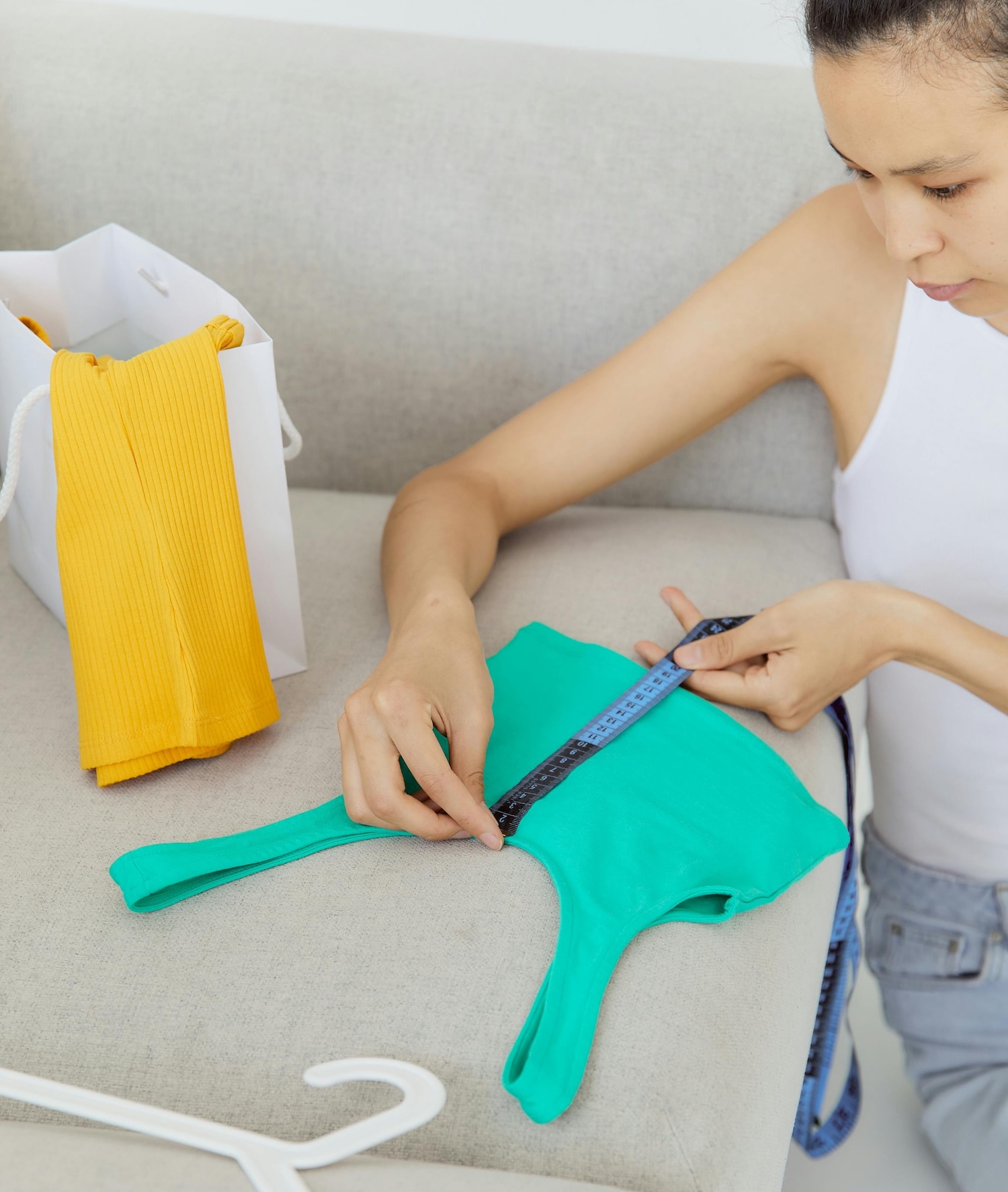
Shifting our style mindset: A seller’s advice on making vintage fashion work for plus-size shoppers
The founder of size-inclusive shop Carmine & Hayworth Vintage gets real about the realities of shopping for plus-size vintage fashion — and what you can do about it
“Vintage clothing was not made for a body like mine!”
This is a statement I hear regularly from my customers — and they’re right, but not in the way that you think.
I’m not going to sugarcoat it: if you are “plus size” and looking for vintage clothing pre-1970s, it’s not going to be easy.
If you read that and thought to yourself, “Great talk, Courtney, how is that supposed to make me feel better?”, I promise we’ll get there.
As a “plus size” woman living in the United States Midwest, I’ve walked into many vintage clothing shops prepared for the metaphorical battle of finding clothing in my size.
If the racks aren’t already separated by size, then I use my trusty eyes and measuring tape to chip through the options.
Here’s what often happens: I see, in the corner of my eye, a piece that instantly pulls me to it. I reach for the garment as if reaching for a trophy…only to find that it’s too small.
The instant feeling of deflation sets in fast.
After accepting my defeat, I resign myself to the jewellery section, where I’ll have better luck.
Why is it so hard to find vintage plus-size clothing?
You hear it in real estate and it applies to vintage clothing, too: location, location, location!
Unless you live in or near a metropolis such as Los Angeles, New York City or Toronto, your options can vary greatly.
If you find yourself shopping for vintage clothing in large cities, you’ll find that there are more options (albeit still not enough). More people, as well as wider access to shops, tailors and textiles, equals more available clothing.
Several years ago, I was in Denver visiting family and went into a secondhand store that carried pre-owned modern clothing. In the back corner of the store was one solitary rack packed solid with vintage clothing of many sizes from the 1940s-1970s that were priced to sell quickly.
I asked one of the sales associates how it could be that there was a rack full of amazing, inexpensive vintage sitting untouched in a sea of avid shoppers.
She said that, in Denver, there’s more vintage clothing than the vintage shops can take in, so this particular boutique decided to carry a rack of vintage, in the back, for anyone who cared to find it. This treasure trove was packed with pieces ranging in decades, sizes, colours and styles.
So not being located in a big city doesn’t mean there aren’t gems to be had. (They just take a little more work to find.)
And some of the best pieces I have sourced came from smaller towns.
My favourite example came from a buying trip I made to a small farming town in rural North Dakota: I purchased clothing from a family and acquired a lovely maroon-and-white striped linen dress made in the 1940s. The material was a casual linen, but the style was very much cocktail.
On the side of the dress was a dart that could be cinched in and let out up to four inches, as desired. Since this family didn’t have easy access to a larger city with more clothing/textile options, they had to make the clothing they wear work for their bodies.
This particular dress could cinch and expand as the wearer’s body did, which meant this garment would last until it fell apart from wear. The fact that this dress was still intact was a combination of luck and being stored properly.

Accessibility is an issue
Here’s the problem: Most of us don’t have the luxury of traveling to multiple vintage shops in various cities in search of size-inclusive vintage clothing. We have the modern convenience of shopping online, but, as with any type of clothing, that presents its own set of struggles.
Why is this such a huge problem for the vintage clothing community?
Here’s what I’ve seen in my 12 years as a vintage seller:
- A lack of size options eliminates a number of shoppers who might otherwise be purchasing vintage. According to CNN, about 60 per cent of women from the United Kingdom and the United States are size 16, which is what’s considered “plus size.”
- Not finding anything in your size after trying a couple of stores discourages consumers from shopping for vintage clothing in the future.
- A lack of size options perpetuates the idea that there’s exclusivity in shopping vintage fashion.
The truth, straight from a seller
I cannot source what isn’t there.
I once asked a museum curator why there weren’t more examples of sizing in their clothing collection.
She said there’s a reason why you only see smaller-sized clothing items on display. Think of what you wore and kept when you were younger (like your high school prom dress).
Are you still able to fit that? For me, I haven’t been able to fit into my senior prom dress since I wore it to prom. It has since been relegated to my storage unit, where it has been packed in perfect condition since.
The same cannot be said for the clothing I wear today, which I wear until it’s within a shred of its life.
Continued below
Find vintage and secondhand near you
View our event calendar
Continued from above
As our bodies develop and change, we shed the clothing of our youth like snakes shed their skin. Our body grows and leaves behind the clothing that symbolized that period in our lives, much like vintage clothing.
Just as quickly as our bodies change, so does society’s view of what the ideal body looks like. The Renaissance Period had the rounded curves of Botticelli’s Birth of Venus, the 1920s had straight, shapeless silhouettes, the 1950s had the hourglass ideal of Marilyn Monroe, the 1990s had the Kate Moss “heroin chic” ideal.
It’s hard not getting whiplash from all of the expectations our bodies have been subjected to over history — and our clothing shows it!
Another thing that’s commonly forgotten: shapewear. When we think of shapewear today, we place it in two camps: optional or statement.
Shapewear is used either as an option that smoothes or cinches to help clothing fit better, or as a main garment staple — e.g., Kim Kardashian wearing a flesh-toned shapewear corset under her couture Schiaparelli gown.
But if you were wearing pre-1970s clothing at the time it was made, then shapewear was not optional. It was a staple of every outfit. This meant many tailored pieces were constructed with the shapewear (i.e. bra, waist cincher, girdle) already in mind. The clothing wasn’t meant for larger bodies, unless they were wearing shapewear.

How to make vintage pieces work for your body
Before I was a vintage clothing seller, I was (and still am) a vintage clothing buyer, which means I’ve learned how to make the vintage clothing available work for me. This all comes down to my favourite subject: styling.
Contrary to what has been ingrained into us, clothing is meant to work for you, not vice versa. Just because a vintage sweater is marked as a size small or medium doesn’t mean you have to accept what’s on the tag!
Use your own personal style to make a garment work for you.
One of my favourite styles of sweaters are “pin-up-girl sweaters,” which were cropped to hit the waist of a skirt. If I love a vintage sweater that isn't my size, but it has a safe stretch, then I make it work for me and wear it like a pin-up girl sweater.
Clothing can be an art, which means you can mould it into your vision of style.
Love the vintage dress you tried on, but your boobs make the dress lose inches in length? Slap on some cute pants and wear it as a tunic.
Can’t button a super cute ’90s button-down dress? Keep it open to make it a unique duster.
Having a hard time finding vintage clothing, period? Vintage styling isn’t just limited to garments!
One of my fashion-forward customers couldn’t find a vintage halter top in her size, so she took a 1970s fringe shawl and tied it into a halter-style top that would’ve made Stevie Nicks drool. Throw on some vintage bangles and sunglasses to create a vintage look no one else has.
Fashion was not only meant to serve a function — it’s supposed to represent you.
What’s the future of plus-size vintage?
Vintage fashion is like rings in a tree: each garment tells us about the particular time it was made.
Decades from now, vintage clothing will hit an interesting stride. The fast-fashion clothing of the early aughts to mid-2020s, such as Forever 21, H&M, Shein and Temu, may not even last a year, let alone a couple of decades.
That means we may have a gap in available vintage clothing until 20 years after 2021, which was when smaller, indie brands and makers with higher-quality garments started catering to more inclusive sizing.
The vintage of the future is going to look a lot different than the vintage of today because the way we wear, the way we make and the way we see clothing is different than the generations before us.
Part of what has helped me when shopping for inclusive vintage clothing was learning that the lack of sizing wasn’t a commentary on my body, but a small snapshot of a certain period in time.
Thankfully, one big difference in vintage shopping since I started out is the access to so many more sellers across the world via social media and the internet.
Since the pandemic, I’ve seen an explosion of amazing vintage sellers that cater specifically to those looking for inclusive vintage. These sellers know how it feels to try and find inclusive sizing, so they make sure the measurements are comprehensive and shown on bodies that represent us.
Through social media, the conversation about how many feel excluded from shopping vintage clothing has given rise to a whole new generation of sellers who hear you.
Thanks to Instagram, I’ve found sellers like Luvsick Plus, Heavy Duty Vintage and Witch Bitch Thrift who curate the best in size-inclusive and gender-inclusive vintage up to size 5X, and they show their customers how to work these pieces into their own style.
Through shops like these, the future of plus-size vintage has never been more exciting.
Courtney Schur is the owner-founder of Carmine & Hayworth Vintage, a size-inclusive vintage shop that stocks a range of vintage and contemporary fashions up to a size 5X, as well as accessories, decor and gifts, in Fargo, North Dakota. She is also a member of The Vintage Seeker.
Thank you for valuing our work!
Support our work to see this page.
You’ve got a good eye, but this gem is only available for members. Register for a plan or upgrade your current one to peek behind this vintage curtain, or log in below.















